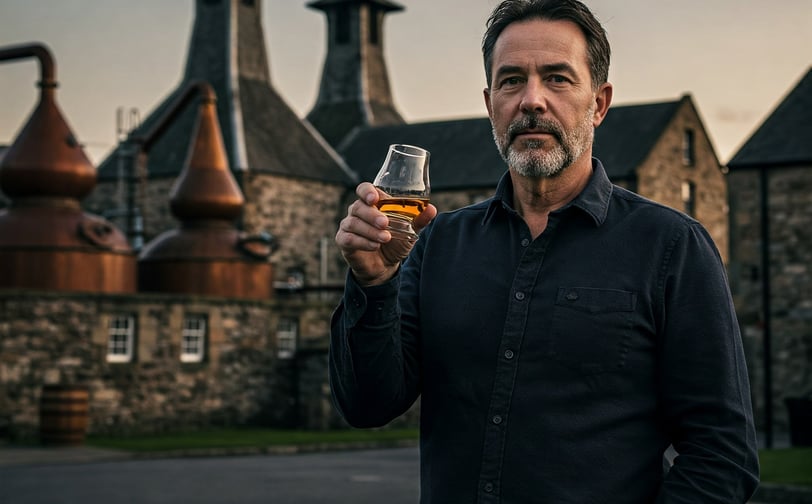Whiskey vs. Bourbon vs. Scotch: Understanding the Differences in Manufacturing
If you’re a spirits lover, you’ve probably come across the terms “whiskey,” “bourbon,” and “scotch.” While all of these types of spirits share some similarities, each has its own unique characteristics that make them special. In this article, we’ll explore the differences in how these three types of whiskey are made, helping you better understand what’s in your glass and appreciate each sip even more.
CURIOSITIES
3/27/20257 min read


What Defines Each Type of Whiskey?
Before we dive into the specifics of making it, it’s important to understand what defines each type of whiskey. The word “whiskey” (or “whiskey,” depending on the region) refers to a broad category of distilled spirits made from fermented grains. However, the rules and ingredients vary by region and style.
Scotch Whiskey: Produced in Scotland, scotch must be aged in barrels for at least three years. It is made primarily from malted barley.
Bourbon: Originating in the United States, specifically Kentucky, bourbon must contain at least 51% corn in its recipe and be aged in new charred oak barrels.
Irish Whiskey: Made in Ireland, it is generally milder and can be made with a blend of grains. Irish whiskey is often triple distilled.
What is Whiskey?
Whisky is a world-renowned distilled beverage that is known for its wide range of flavors and aromas, originating from the fermentation of grains. The whisky production process involves several crucial steps: grain selection, milling, fermentation, distillation and aging in wooden barrels. The most common grains used in the production of whisky include barley, corn, rye and wheat, each contributing uniquely to the final profile of the drink.
The different categories of whisky are based on variables such as geographic origin, the type of grain used and the distillation method. The main categories include Scotch, Bourbon and Rye, each of which is marked by specific characteristics. Scotch, for example, must be produced in Scotland and generally has a smoky flavor, which can be intensified by the use of peat in the drying process of the barley. Bourbon, on the other hand, is typically made from a mash bill that contains at least 51% corn, resulting in notes of caramel and vanilla due to the intense contact with new wood during aging.
Another important aspect of whiskey is its alcohol content, which usually ranges between 40% and 50%. However, the content can be adjusted slightly during bottling. Whiskey lovers often express a preference for certain types, aligning their choices with their personal preferences in terms of flavor and aroma. Knowing the differences between the categories and the production techniques is essential for any lover of distilled beverages, as it provides a solid foundation for exploring the rich varieties available in the world of whiskey.
The Distinction of Bourbon
Bourbon is a variety of whiskey that has unique characteristics resulting from its origins and the rigorous manufacturing process it follows. In order for a drink to be classified as bourbon, it must be produced in the United States, with at least 51% corn in its composition. Additionally, it must be distilled to an alcohol content of no more than 160 proof and aged in new oak barrels, which give the liquid a distinct and complex flavor.
Bourbon’s roots date back to the early 19th century, primarily in the Bourbon County region of Kentucky. Although bourbon is often associated with this region, it can be produced anywhere in the United States, as long as it follows the established legal requirements. The use of corn is one of the aspects that differentiates bourbon from other types of whiskey, such as Scotch, which uses malted barley as its base. Corn not only meets the legal requirements, but it is also responsible for the sweet and creamy flavor that characterizes bourbon.
In addition to the ingredients, the production process of bourbon also plays a crucial role in its distinction. After fermentation, the liquid is distilled and then transferred to internally charred oak barrels. The contact between the whiskey and the wood imparts notes of vanilla, caramel and spices, enriching the flavor profile. To properly enjoy bourbon, it is recommended to serve it in a suitable glass, allowing the aromas to develop. Enjoying it neat or with a splash of water can enhance its characteristics, providing a deeper experience. As a result, bourbon offers a tasty journey through its rich history and secret production methods, cementing its special place among spirits lovers.
The Tradition of Scotch
Scotch, a form of whisky that originated in Scotland, is renowned around the world for its complexity and variety. The history of Scotch dates back several hundred years, with the first documented mentions dating back to the 15th century. The Scots developed Scotch as a reflection of their culture and the unique environment in which they live, and its production is surrounded by a rigorous distillation process.
When it comes to distillation, Scotch is made in distilleries that follow ancient practices, which can include the use of pure Scottish highland water and malted barley. The process takes care of every detail, from fermentation to double distillation, which helps to maximize the desired flavors and aromas. This meticulous attention to traditional methods contributes to the richness of flavor and complexity that characterizes Scotch.
There are different varieties of Scotch, the best known being single malt and blended. Single malt is made in a single distillery and is 100% malted barley-based, while blended whiskies combine whiskies from different distilleries, offering a more diverse and accessible flavor profile. Each type has its own nuances and characteristics, depending on the production techniques used and the specific origin of the raw materials.
Another crucial factor in defining the character of Scotch is maturation in oak barrels. This stage, not only legally required, influences the final taste, giving notes of fruit, spices and even smoke, depending on the type of barrel used. The combination of aging time and the barrels used results in a wide range of flavors and aromas, elevating Scotch to a level of sophistication appreciated by connoisseurs and lovers of distilled beverages around the world.
Ingredients Used in Each Style
Scotch Whisky
Scotch is traditionally made with malted or unmalted barley. The choice of grains is crucial to the final flavor of the drink. Furthermore, the water used in production also plays a vital role; many Scottish distilleries use specific natural sources that give the product unique characteristics.
Notable Examples:
Glenfiddich 12: One of the world’s best-selling single malts, known for its fruity flavor and floral notes.
Lagavulin 16: A scotch famous for its intense and complex smoky flavor.
Bourbon
As mentioned earlier, bourbon must contain at least 51% corn. The remainder of the mash bill may include other grains such as rye, wheat, or barley. The use of corn gives bourbon its characteristic sweet flavor. Additionally, the water used must be pure and free of impurities to ensure the quality of the final product.
Notable Examples:
Buffalo Trace: An affordable bourbon with notes of caramel and vanilla.
Maker’s Mark: Known for its smooth, sweet flavor due to the addition of wheat to the mash bill.
Irish Whiskey
Irish whiskey can be made with a combination of malted and unmalted barley. One of the defining characteristics of Irish whiskey is that it is typically triple distilled, resulting in a smoother, lighter spirit compared to its competitors.
Notable Examples:
Jameson: One of the most popular Irish whiskeys in the world, known for its smoothness and versatility.
Redbreast 12: A highly regarded pot still whiskey with rich, complex flavors.
Specific Brewing Processes
Scotch Whisky
Malting: Barley is soaked in water and allowed to germinate before being dried in a kiln. This process develops the sugars needed for fermentation.
Mashing: Dried malt is ground in a mill to create a fine powder called "grist." This grist is mixed with hot water in large tanks called "mash tuns" to extract the soluble sugars.
Fermentation: The heated mash is transferred to tanks where yeast is added to ferment the sugars into alcohol over several days.
Distillation: The fermented liquid (wash) is distilled twice in traditional pot stills. The first distillation produces a liquid called "low wines," which is then distilled again to increase the alcohol content.
Aging: Scotch must be aged for at least three years in used or new oak barrels. During this time, it acquires complex flavors from the wood.
Bourbon
Grain Blending: The grains are ground separately before being mixed with hot water to create a paste called a “mash.”
Fermentation: The mash is cooled before specific yeasts are added that help develop unique flavors during the fermentation process, which lasts about three days.
Distillation: The fermented liquid is distilled in continuous stills or pot stills until it reaches an alcohol content of between 60% and 70%.
Aging: Bourbon must be aged in new barrels made exclusively from charred oak for at least two years (to be called just bourbon) or four years to have a specific age listed on the label.
Bottling: After proper aging, bourbon can be diluted with water to reach the desired alcohol content before bottling.
Irish Whiskey
Malting: Similar to Scotch, but often uses unmalted barley as well to create different flavor profiles.
Mashing: The grains are ground together and mixed with hot water to extract soluble sugars.
Fermentation: The mash ferments for a longer period of time than Scotch due to the controlled temperature during this process.
Distillation: Typically triple distilled to smooth out the flavor; this means the fermented liquid goes through three distinct cycles in the still.
Aging: Must age for at least three years in barrels; many producers use barrels previously used for other spirits such as wine or bourbon to add complexity to the final flavor.
How Distillation Affects the Final Flavor of Whiskey
Distillation is one of the most critical processes in whiskey making and has a significant impact on the final flavor of the spirit:
In Scotch, double distillation allows complex flavors to develop while retaining some of the more subtle notes of the barley.
In Bourbon, continuous distillation can result in a purer, more concentrated spirit due to the high efficiency of the process; this contributes to its characteristic sweet profile.
In Irish Whiskey, triple distillation results in a characteristic smoothness that makes this spirit very accessible to beginners; this smoothness allows the fruity flavors to shine through without being overshadowed by the alcohol intensity.
Now that you know the key differences between Scotch, Bourbon, and Irish Whiskey—from the ingredients to the manufacturing processes—it’s easier to choose which one to try or enjoy! Each type comes with a rich cultural and technical history that is worth exploring.
So, which one would you like to try? Follow our recommendations to find out what you like best. And take the opportunity to discover new ways to enjoy this drink that is so popular around the world.


